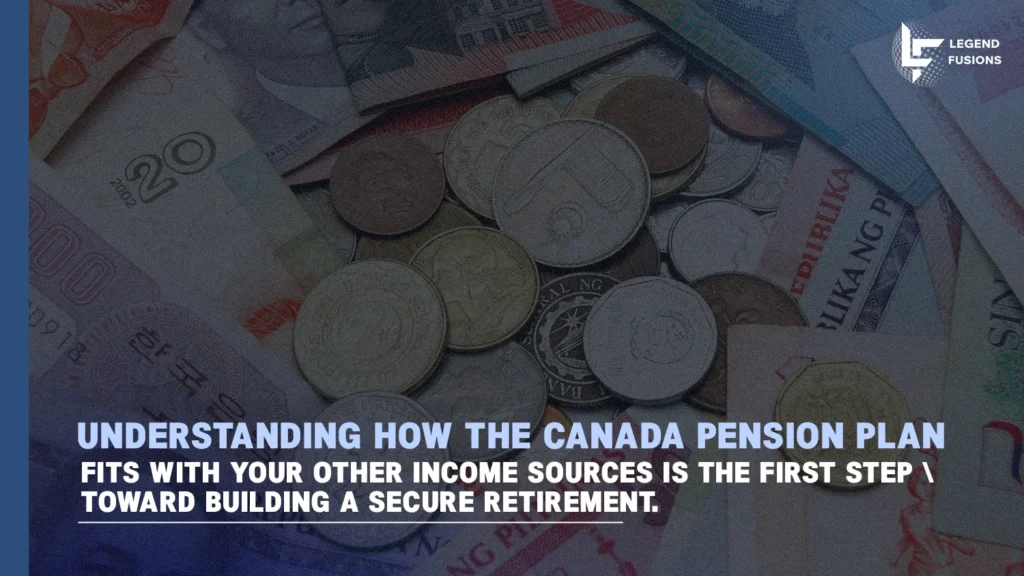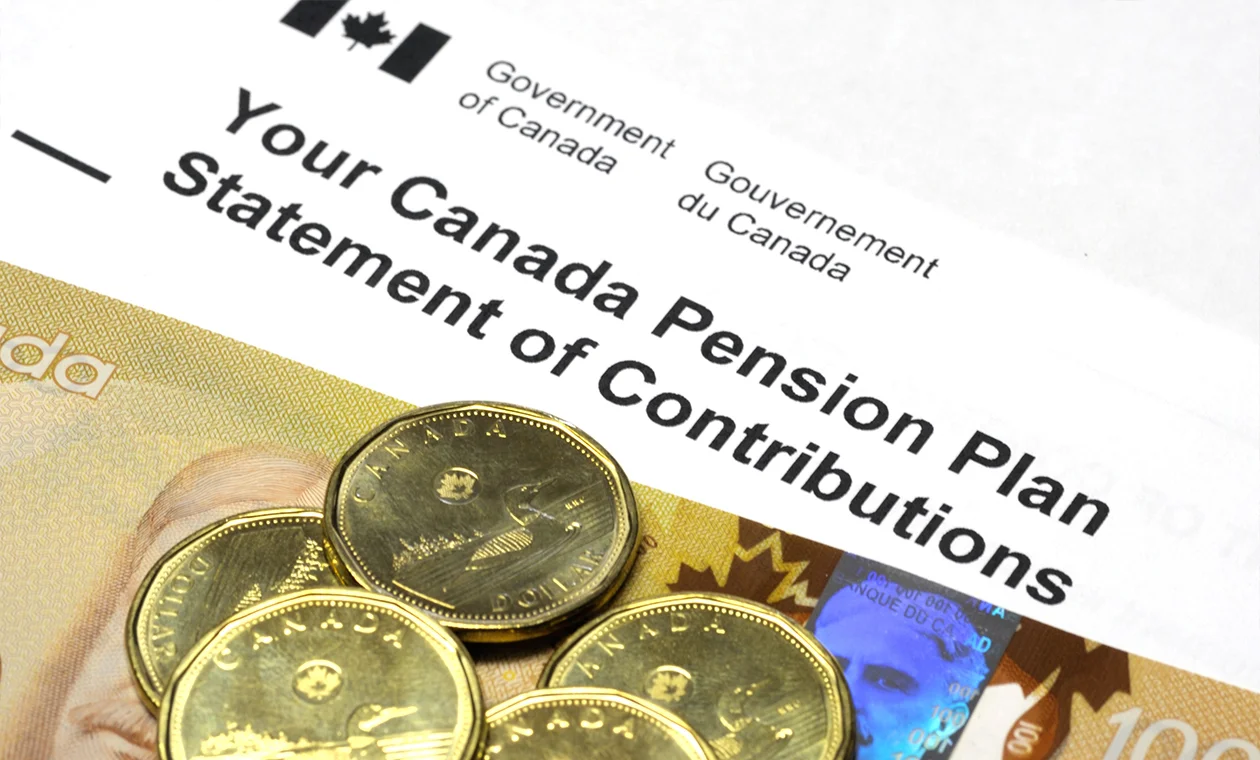One of the most important pillars of your future financial security is the Canada Pension Plan (CPP). This program provides you with steady income when you retire, face disability, or lose a loved one.
In this guide, you’ll learn how the Canada Pension Plan works, explore the different CPP benefits available, understand how to apply for CPP, and see how it fits into your retirement strategy.
Let’s move towards a successful financial future, step by step.
What Exactly is the Canada Pension Plan (CPP)?
Your Canada Pension Plan (CPP) helps you replace part of your income after you retire, become disabled, or pass away.
Throughout your working life, you and your employer make regular CPP contributions based on your salary. These contributions go into a large pension fund managed by the Canada Pension Plan Investment Board (CPPIB). This invests the money so that it grows and stays sustainable for future generations.

Who Is the CPP For?
The CPP covers nearly all working Canadians as long as you’re earning a regular income and are over the age of 18. Contributions are mandatory if you earn more than $3,500 annually. This is known as the basic exemption amount.
If you live in Quebec, you’ll be part of a similar program called the Quebec Pension Plan (QPP) instead.
What’s the Purpose of the CPP?
The main goal of the CPP is to provide you with a partial replacement of earnings if:
- You retire from work (CPP retirement pension)
- You’re no longer able to work due to a long-term disability (CPP disability benefit)
- A loved one passes away, and you qualify for survivor benefits

How CPP Contributions Work
Your Canada Pension Plan contribution is an investment in your financial security. It plays a vital role in building your future retirement income through tax-deductible contributions, whether you’re employed or self-employed.
For 2024, the employee contribution rate is 5.95% on your pensionable earnings, which are between $3,500 and $68,500.
If you’re employed, your employer matches your contribution. If you’re self-employed, you pay both portions, totaling 11.90%..
These contributions lower your taxable income today and secure your retirement tomorrow.
What If You're Self-Employed?
If you’re registering the birth of your child with your province or territory, you can apply for the CCB at the same time. This is often the quickest and easiest method, and it’s available in most parts of Canada.
Just check a box during registration, and your information gets shared with the Canada Revenue Agency (CRA) automatically.
What If You're Self-Employed?
CPP entitlement is based on your pensionable earnings, not on the total amount you contribute. As a self-employed individual, you are required to pay both the employee and employer portions of CPP contributions.
Unlike employees, self-employed individuals pay their CPP contributions when they file their personal income tax return with the CRA. The CPP amount is calculated based on net self-employment income and is reported on Schedule 8 of the tax return.
The Enhanced CPP
Since 2019, the CRA has been rolling out the Enhanced Canada Pension Plan. This enhancement involves gradually increasing contributions to ensure higher CPP benefits in the future. Over time, this translates into greater financial support for you during retirement or in case of a disability.
A Look at All Types of CPP Benefits
The Canada Pension Plan offers a range of CPP benefits to support you and your family through various life stages. Here’s what you need to know:
1- Your CPP Retirement Pension
This is the core benefit most Canadians associate with the CPP. You can start receiving your CPP retirement pension as early as age 60 or delay it until age 70.
- Starting at 65 is considered the standard and gives you the full pension amount.
- Starting early (60–64) reduces your monthly payments, but you receive them longer.
- Delaying past 65 increases your monthly payments—by up to 8.4% more for each year you wait, up to age 70.
Your choice depends on your financial needs, health, and whether you plan to keep working.
2- CPP Disability Benefit: Support When You Can’t Work
If a severe and prolonged disability prevents you from working, the CPP disability benefit provides monthly financial support.
To qualify, you must:
- Be under 65
- Have made enough CPP contributions
- Have a long-term disability that keeps you from working any job on a regular basis
There’s also a CPP children’s benefit available to dependent children of those receiving the disability benefit—offering added security for your family.
3- Survivor Benefits: A Safety Net for Your Loved Ones
When a CPP contributor passes away, their loved ones may qualify for CPP survivor benefits, which include:
- Death Benefit: A one-time, lump-sum payment to the estate (up to $2,500)
- Survivor’s Pension: Ongoing monthly payments to the spouse or common-law partner
- Children’s Benefit: Monthly payments for dependent children under 18 (or up to 25 if in school)
These benefits help ease the financial burden during an already difficult time.
4- Post-Retirement Benefit: Still Working While Receiving CPP?
If you’re between 60 and 70 and still working while receiving your CPP retirement pension, you may continue contributing to the plan.
- For those aged 60 to 64, these contributions are mandatory if you are working and receiving your CPP retirement pension.
- For those aged 65 to 70, these contributions are optional, and you can choose to continue contributing or elect to stop.
These extra contributions go toward the Post-Retirement Benefit (PRB), which increases your pension amount, even after you’ve already started collecting it. It’s a simple way to grow your income while staying active in the workforce.
How Much CPP Will You Actually Get?
CPP isn’t a flat-rate benefit. Instead, it’s structured around your personal work and contribution history. Your monthly CPP payment depends on how much you earned and contributed during your working years. The more you contributed, and the longer you contributed, the more you’ll receive in retirement.
Key Factors That Affect Your CPP Amount
Several elements influence your final payment:
- Total CPP contributions during your career
- How long you contributed to the plan
- Your earnings history (higher average income usually equals higher benefits)
- The age you start your CPP (early = reduced benefits, late = increased benefits)
- Annual cost of living adjustments based on inflation
These variables mean everyone’s CPP benefit is a little different.
The best way to find out your personal estimate is through your My Service Canada Account. Once logged in, you can view your CPP contribution history, see a personalized benefit estimate, and even simulate different retirement ages.
What’s the Average CPP Payment?
In 2025, the average CPP retirement pension for new beneficiaries at age 65 is around $808.14 per month.
The maximum monthly amount at age 65 for 2025 is $1,433.00, but very few Canadians qualify for the full amount.
Note: These numbers are adjusted each year to help keep up with the cost of living. Your own payments may be higher or lower depending on your situation.
How and When to Apply for Your CPP?
You should apply for CPP retirement pension about 6 to 12 months before you want your payments to begin. The earliest you can apply is at age 60, even if you’re still working. Starting early reduces your monthly amount!
The fastest and most convenient method is to apply online through your My Service Canada Account. Here’s how:
- Sign in or create your account.
- Go to the CPP section and choose “Apply for CPP Retirement Pension.”
- Follow the guided steps and submit your application.
You’ll get a confirmation once your application is received. You can also check the status directly from your account.
If you’re more comfortable with paperwork, you can still complete a paper application form. Download it from the Service Canada CPP page or request a printed copy by phone or in person at a Service Canada office.
Don’t Forget Your CPP Payment Dates!
CPP payments are made monthly, usually near the end of each month. For the most up-to-date information, you can visit the official CPP payment dates calendar.
Stay informed with Legend Fusions to help you plan your monthly finances with confidence.
How CPP Fits with Your Other Retirement Savings
At Legend Fusions Canada, we look at the whole picture. We combine CPP benefits with other income sources to create a retirement plan that’s stable, sustainable, and suited to your needs.
CPP + Old Age Security (OAS)
The Old Age Security (OAS) pension is based on how long you’ve lived in Canada. It starts at age 65 and complements your CPP retirement pension by adding another monthly payment stream.
Together, CPP and OAS form the foundation of government support for retirement.
CPP + Registered Retirement Savings Plans (RRSPs)
Unlike CPP and OAS, RRSP is a personal savings tool. You contribute to it throughout your working life and enjoy tax-deferred growth on your investments. When you retire, your RRSP converts into income, giving you more flexibility and control.
CPP + Workplace Pension Plans
If you’re part of a workplace pension plan, you’re already one step ahead. These employer-sponsored plans add yet another layer of financial protection in retirement. Combined with CPP contributions and personal savings, a workplace pension gives you a more predictable and comfortable income stream.
Is Your CPP Taxable? What You Need to Know
Yes, CPP payments are considered taxable income. The money you receive from your Canada Pension Plan gets added to your total income for the year and may affect how much tax you owe at tax time.
Also, you can choose to have federal income tax deducted directly from your monthly CPP payments. This helps you avoid surprises when you file your taxes.
To set this up, simply log into your My Service Canada Account, go to your CPP section, and request tax withholding. You can adjust the amount any time.
FAQs
Yes. You can start CPP as early as age 60 even if you’re still working. If aged 60-64, you must contribute. If aged 65-70, contributions are optional but increase your pension via the Post-Retirement Benefit.
It depends on your situation. Taking it at 60 means smaller, longer payments (up to 36% less). At 65 is the standard full amount. Delaying to 70 means larger, shorter payments (up to 42% more). Use My Service Canada Account for personalized estimates.
Your CPP payments are adjusted annually every January based on the Consumer Price Index (CPI) to keep pace with inflation. For instance, in 2025, benefits increased by 2.6%.
CPP payments are made monthly, generally on the third-to-last banking day. For 2025, key dates include January 29, February 26, March 27, April 28, May 28, June 26, July 29, August 27, September 25, October 29, November 26, and December 22. Check Canada.ca for the full schedule.
The CPP applies to workers in all Canadian provinces and territories except Quebec, which has its own similar, but separate, Quebec Pension Plan (QPP). Both provide retirement, disability, and survivor benefits based on contributions, with sharing agreements for those who’ve contributed to both.
Secure Your Future with Confidence
The Canada Pension Plan is just one piece of your retirement puzzle. To truly make the most of it, you need more than just basic knowledge. At Legend Fusions Canada, we understand that strategic planning pays off. We help you see the full picture, so every income source works together to support your lifestyle and goals. As experienced tax accountants in Mississauga, we specialize in retirement and tax strategies for hard-working Canadians like you.
Feeling overwhelmed? You don’t have to be. Contact Legend Fusions Canada today to schedule your free consultation

Jeffrey Ross
Jeffrey Ross is an experienced tax accountant focused on US-Canada cross-border taxation, with over three years in the industry, including a key role as client manager at a Canadian tax firm. He provides expertise in corporate and personal tax planning, specializing in non-resident tax, capital gains, CRA and IRS compliance, and retirement planning. Known for his personalized approach, Jeffrey is dedicated to guiding clients with clear, practical advice tailored to complex tax scenarios, aligned with the evolving tax laws.

